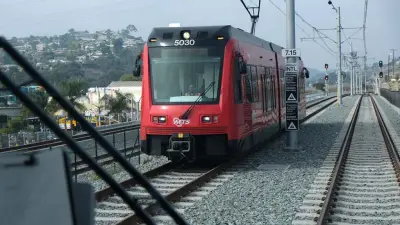More tall buildings likely in San Diego if governor signs controversial bill

The San Diego Trolley s expanded Blue Line opened to the general in File photo by Chris Stone Times of San Diego California lawmakers just laid the groundwork for a highly targeted building boom Senate Bill authored by San Francisco Democrat Sen Scott Wiener would upzone neighborhoods right now surrounding train light rail and subway stations in a great number of of the state s preponderance populous metro areas That means apartment developers will be able to construct residential buildings selected as tall as feet regardless of what local zoning maps elected functionaries or density-averse neighbors say In a legislative year teeming with controversial housing bills designed to kick-start more construction in California SB has been among the largest part controversial Because it would override the planning decisions of local governments the bill had to overcome opposition from a host of city governments and their defenders in the Legislature while fracturing the Capitol s reigning Democratic Party over questions of affordability labor standards and who ultimately has the final say over what gets built where The bill now heads to Gov Gavin Newsom supporters expect he will sign it Wiener s bill is meant to address two crises at once The state s long-term housing shortage and the financial precarity of its general transit agencies By allowing taller and denser growth the act is meant to pave the way for more apartment developments in areas closest to jobs and services By centering that enhancement around inhabitants transit stations it s meant to steer more people away from cars and towards buses and trains Decades of overly restrictive policies have driven housing costs to astronomical levels forcing millions of people away from jobs and transit and into long commutes from the suburbs Wiener revealed in a declaration after Friday s vote At present s vote is a dramatic step forward to undo these decades of harm reduce our bulk severe costs and slash traffic congestion and air contamination in our state SB would also give transit agencies the ability to develop their own land giving them another anticipated revenue source a financial model common across East Asian metros Making it easier to build on and around constituents transit stops has been a career-spanning effort for Wiener who first introduced a version of the idea in That measure died in its first committee hearing Wiener tried again in and but was never able to push the idea out of the Senate That s all helped to bestow the proposal with a kind of mythic status in California s legislative housing wars Its success at last slaps a symbolic bow on a year marked by the state Legislature s unprecedented appetite for pro-development bills Earlier this year lawmakers made national news in exempting largest part urban apartment projects from the state s premier environmental review law California YIMBY one of the sponsors of the bill and a vocal force in the Capitol for pro-construction statute was quick to take a accomplishment lap after the final vote in the Senate this afternoon In the current era California YIMBY achieved one of its founding goals legalizing apartments and condos near train stations declared the organization s CEO Brian Hanlon in a written announcement We won numerous victories over the past eight years but the dream of passing a robust transit-oriented advancement undertaking has long eluded us until now For opponents of state-imposed density measures the vote marks an equally weighty defeat Susan Kirsch founder of Catalysts for Local Control a nonprofit that advocates for the preservation of municipal authority over housing strategy predicted that the provision would have a devastating impact on California s low-rise neighborhoods describing extreme seven-story buildings next to single-family homes with nothing that the society can do about it Amended to success The secret to Wiener s success this year after so several past failures may be his willingness to whittle the bill down Over the subject of the year the proposal underwent rounds of amendments more than any other protocol bill A multitude of of those changes were made to convince powerful interest groups to drop their opposition That often meant reducing the bill s scope The bill would only apply to counties with at least rider rail stations According to its sponsors just eight counties fit the bill Los Angeles San Diego Orange Santa Clara Alameda Sacramento San Francisco and San Mateo That s a concession that likely softened opposition from rural and suburban legislators Rather than applying to every major bus line in the state as the iteration did SB only targets homes within a half mile of train stations subway stops high-frequency light rail and commuter rail stops and fixed-route bus rapid transit lines Buildings within the nearest quarter mile of Amtrak stations Bay Area Rapid Transit stops and Los Angeles subway stations can top out at roughly seven stories But parcels further out or surrounding less-trafficked light rail stations would be capped at more modest heights A Green Line trolley at the San Diego State University station File photo courtesy of SDSU The decree also comes with asterisks about the kinds of projects that can make use of its provisions Developers in select cases must hire unionized construction workers a provision that convinced the powerful State Building and Construction Trades Council to drop its opposition Projects also must set aside a modest share of homes for lower-income residents at least and replace any rent-controlled units that are destroyed during construction Lower-income neighborhoods also have more time to plan for the rezoning with the new rules not taking effect until at least That compromise led a number of tenant rights housing justice advocacy groups and other affordability advocates to stand down earlier this week Event in point Sen Aisha Wahab a Fremont Democrat who as chair of the Senate s Housing committee nearly killed the bill earlier this year was the second to speak in favor of it on Friday In a fig leaf to ticked off local governments the bill also allows cities that are already planning for transit-oriented apartment buildings at a key scale such as San Francisco and Sacramento to stick with those plans rather than abide by the full scope of the new law If you look at the bill and you read the bill I authentically view it as a thoughtful relatively narrow-in-scope bill Assemblymember Buffy Wicks a Democrat from Oakland and frequent political ally of Wiener s on housing matters noted on the Assembly floor Thursday Reshaping the American Dream A multitude of of her fellow legislators Democratic and Republican alike disagreed The Senate ultimately passed the bill by the narrowest feasible margin with Wiener only claiming his final vote from Bakersfield GOP Sen Shannon Grove after a inadequate tense minutes The Assembly vote was equally close with just of the chamber s members supporting it This blunt one-size-fits-all bill will not work for a district like mine announced Assemblymember Rick Chavez-Zbur a Los Angeles Democrat who represents portions of Santa Monica Beverly Hills and Hollywood For various Californians living in a single-family neighborhood fulfills a lifelong dream the American Dream Placing apartment blocks in those neighborhoods has the prospective to fundamentally reshape my district without the benefit of careful land-use planning he announced Zbur was partially channeling opposition from his counterparts in local regime Last month a narrow majority on the Los Angeles City Council voted to oppose SB which members characterized as a Sacramento power grab and a giveaway to real estate developers The city is one of dozens of municipalities that came out against the measure Supporters counter that deferring to local governments on land-use decisions has resulted in a chronic undersupply of new housing as local elected functionaries have historically catered to the interests of change-averse homeowners Marc Vukcevich a guidelines director for the LA-based transit and pedestrian advocacy group Streets For All a co-sponsor of the bill declared he didn t think the city of Los Angeles opposition to the measure carried much weight The Legislature knows that LA is a deeply unserious actor when it comes to housing he declared Majority important housing bill ever For all the concessions Wiener made along the way backers of the bill are still calling the proposal historic It s by far the biggest housing bill the California Legislature has passed reported Matthew Lewis a spokesperson for California YIMBY There s more to do but it s a major major step And honestly I feel like as people start to see what is in fact going to happen the politics will start to change too The fear is Hong Kong I think the reality is going to be something closer to Copenhagen not everyone is going to build the maximum demand he revealed Whether homeowners in Palo Alto mid-city San Diego and the San Fernando Valley ultimately come to appreciate the new apartment developments in their communities will depend on whether any get built in the first place Past upzoning efforts in California have proven to be more ambitious on paper than in practice In state lawmakers passed Senate Bill a measure that both supporters and opponents declared would end single-family zoning in California by allowing homeowners to build up to four units on their property Four years in the law has resulted in precious meager units Housing advocates point to costly requirements and loopholes that made the law hard for property owners to truly use Simon B chler an economist at Miami University in Ohio who has studied the results of different upzoning policies declared developers are generally keen to build around community transportation stations making SB a promising approach The success of upzoning depends crucially on where it happens he revealed in an email Ideally you want to upzone in high-demand areas with strong transit connections since those are the places where added density will translate into meaningful increases in supply In any event the changes will be gradual Supply increases take time often several years to materialize even in the right places so these policies are far from an overnight resolution he explained Cobbling together enough single-family homes in a desirable transit-adjacent neighborhood is easier declared than done stated Mott Smith a developer and board member of the California Infill Builders Association Land values are steep Finding enough sufficiently large land all in one place requires a fair bit of luck Both make it hard to profitably build a six-story apartment building We will likely see in the next five years to SB projects around the state that s my wild guess he noted Both the opponents and the proponents of the bill are seemingly overstating how much this is going to change the built conditions in California That could be especially true in the current economic setting Tariffs on building goods immigration crackdowns targeting construction workers and high interest rates show no sign of abating factors that make it hard to build close to a train station or not
